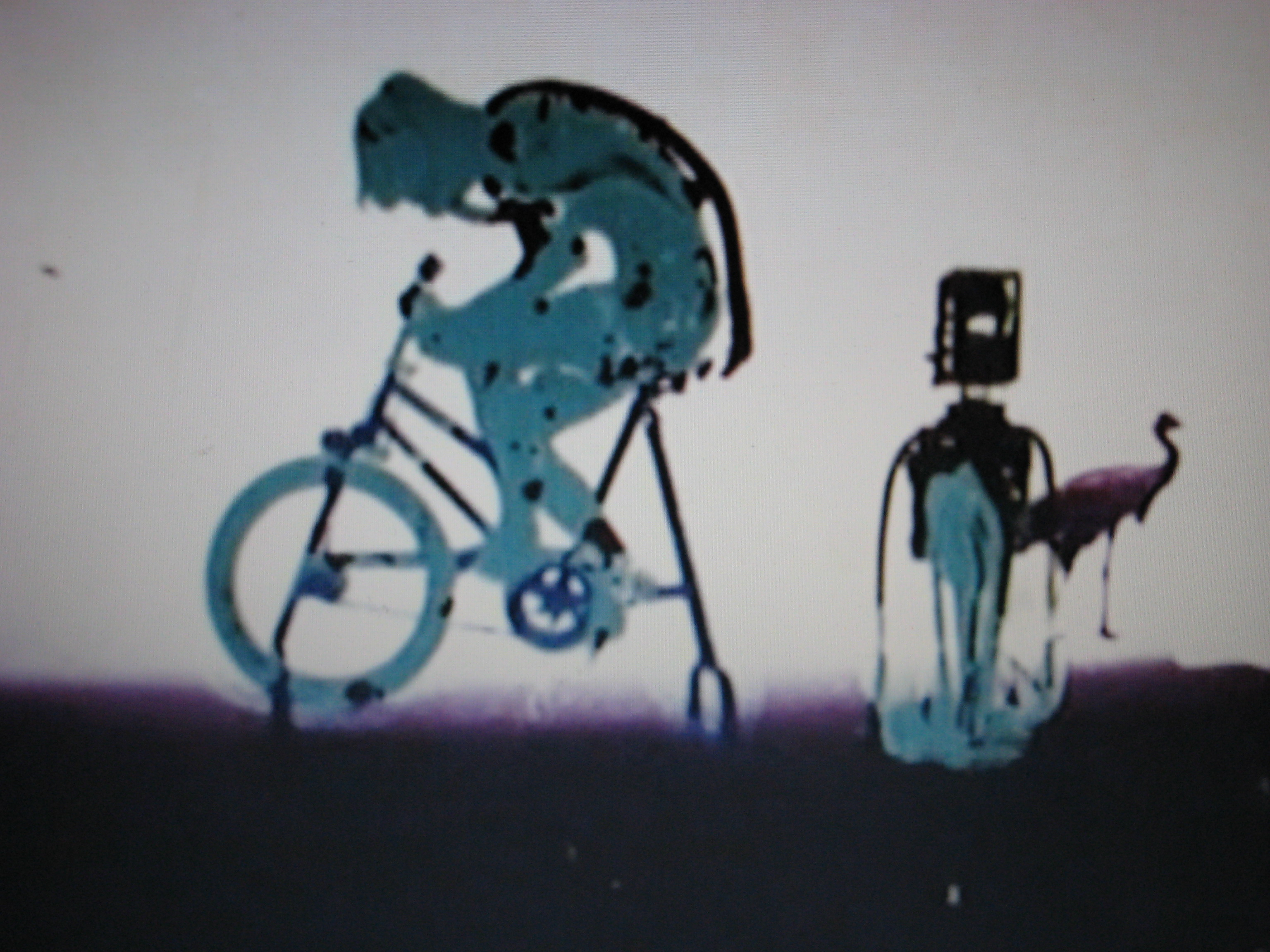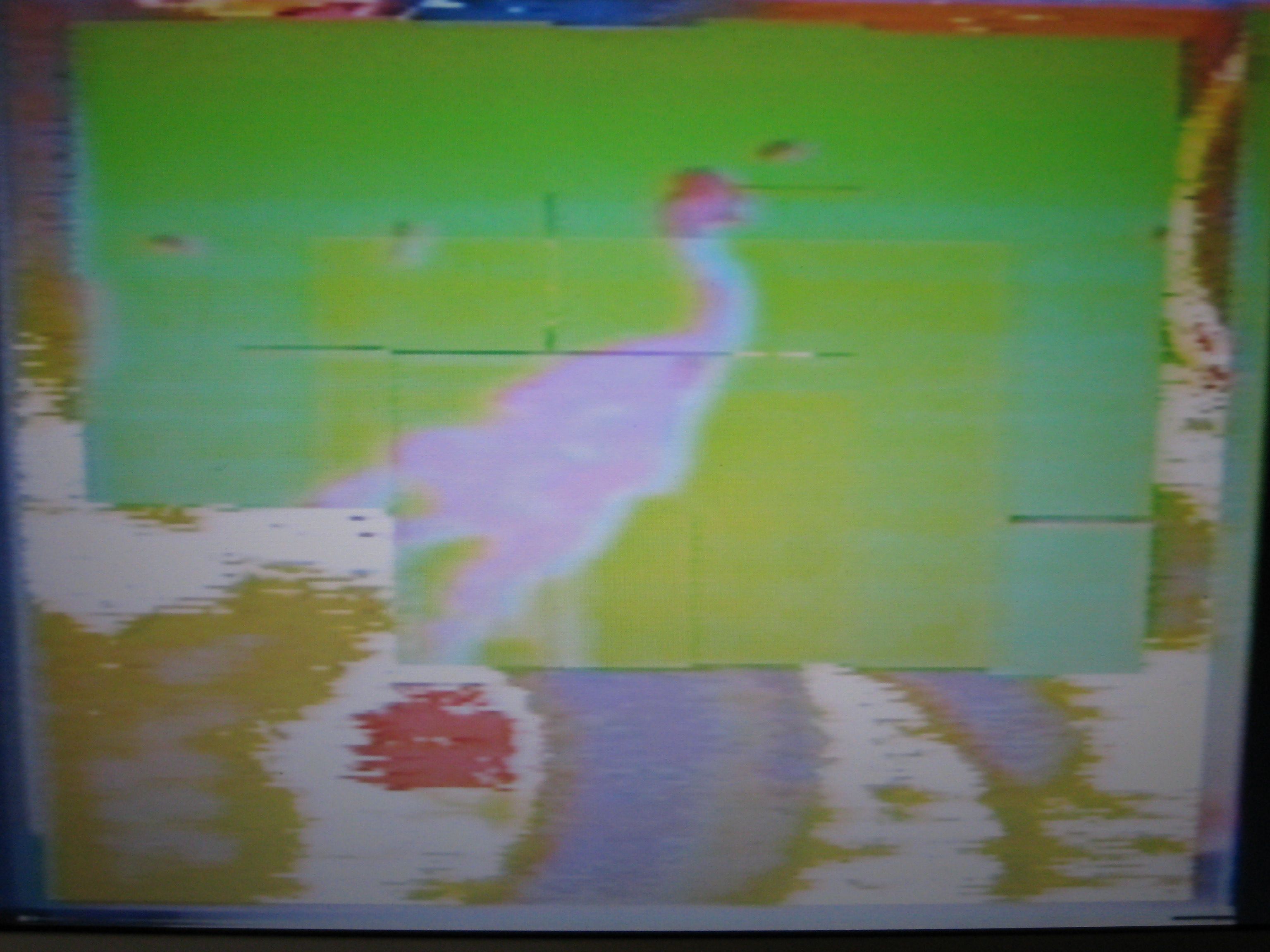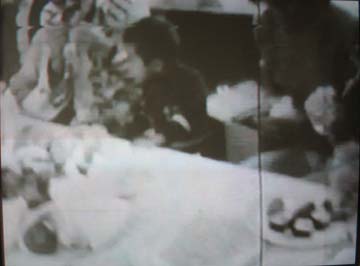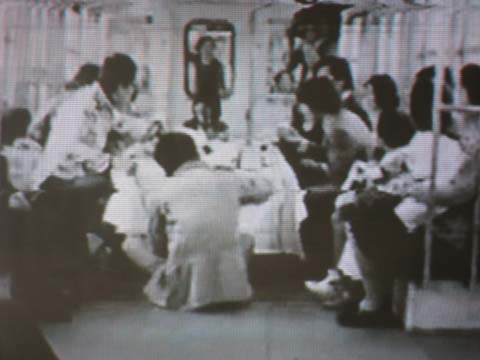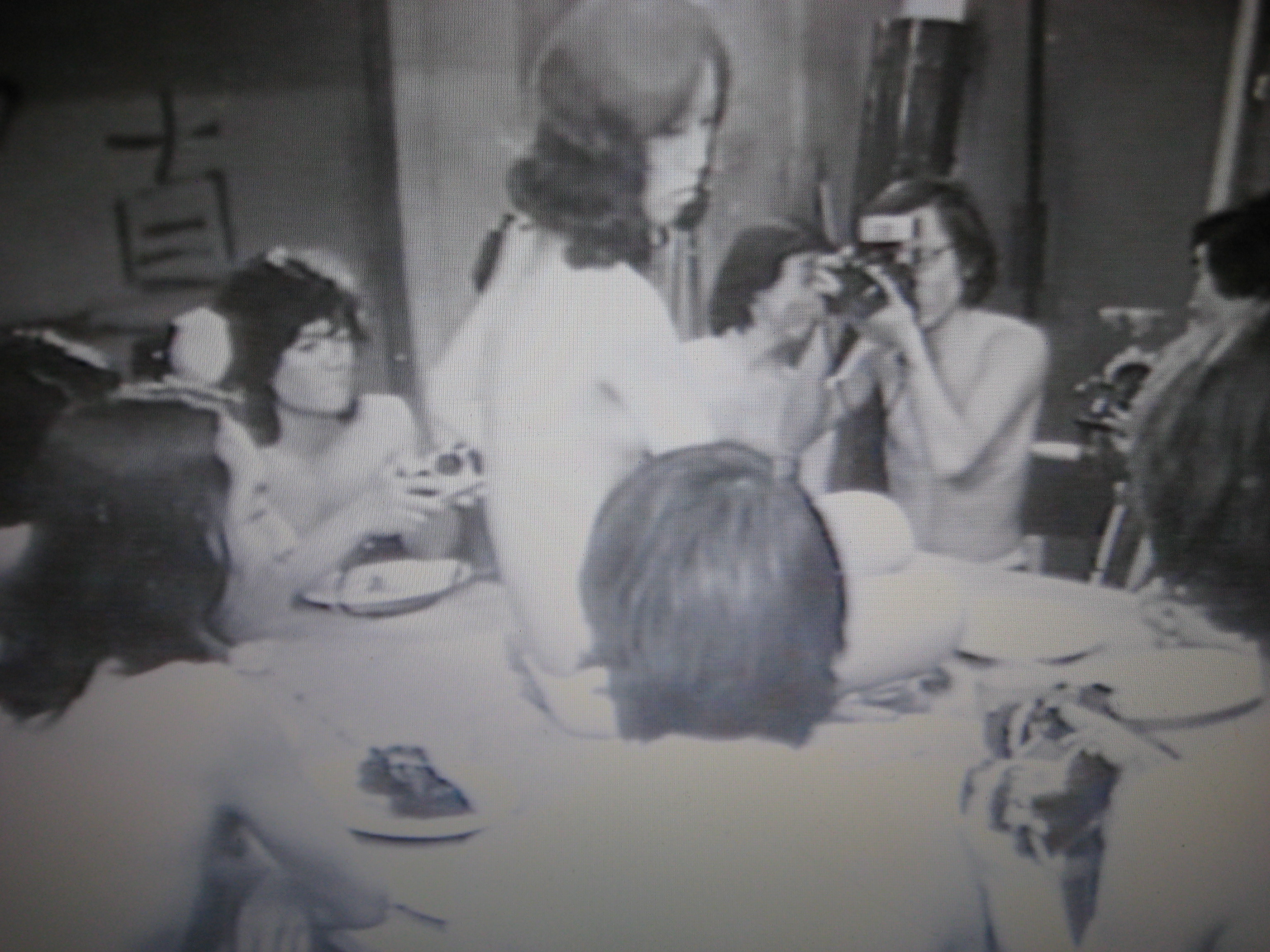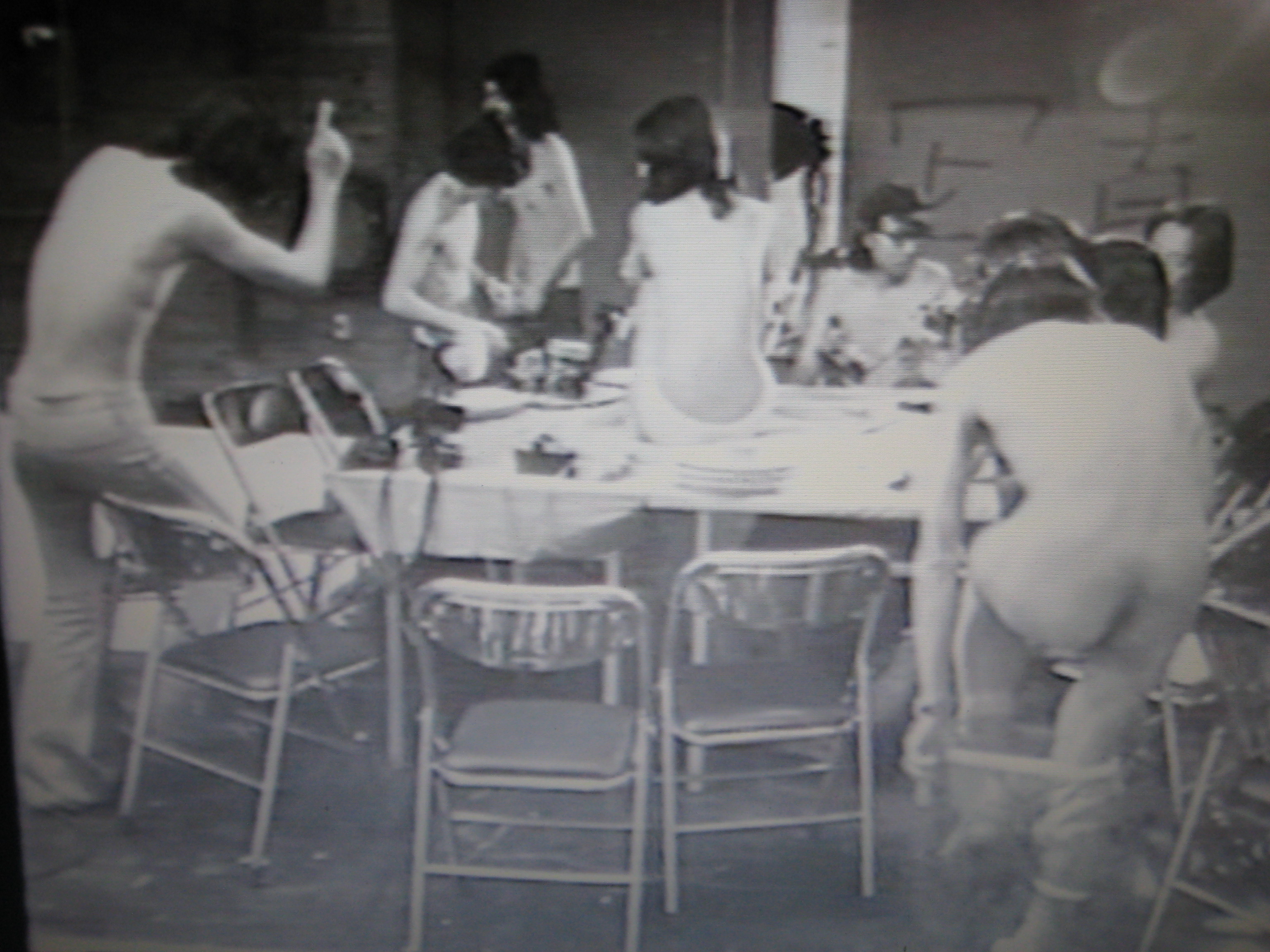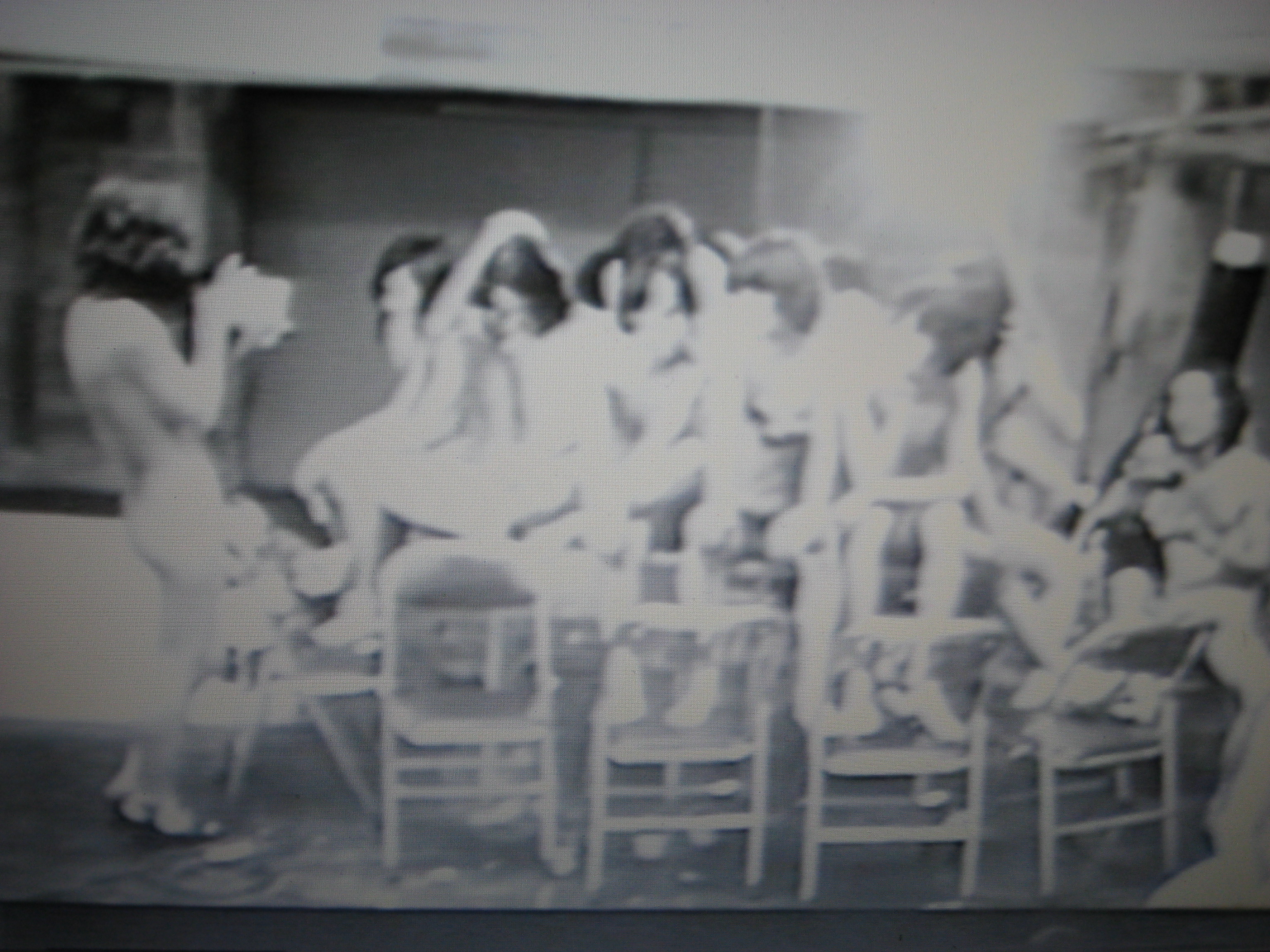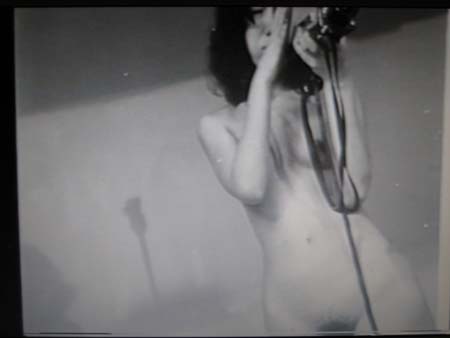Issue 15: Spectacle East Asia (Fall 2010)
WHAT IS PHOTOGRAPHY?: ABSENCE
What is Photography?/Shashin to wa nanika? (hereafter, What Is Photography?)1 is a 1976 video performance made by Tokyo-based video artist and film animator Nakajima Kō and Video Earth, the video art collective co-founded by Nakajima in 1973 (fig. 1).2 Mimicking a commercial photo shoot with a nude female model, the work consists of a double-channel projection featuring a 26 minute black-and-white video of the performance on the left, and an approximately 21 minute “slide show” of black-and-white photographs of the model taken by the participating artists on the right. In its ideal presentation, a wall display of selected photographic prints should accompany the projection. The work was screened only once in Japan, without any photographic prints, as part of a self-curated video screening event at a “rental gallery”-cum-auditorium at the Tokyo Metropolitan Art Museum in the late 1970s.3 However, there was no “public,” so to speak, in this audience, which was wholly comprised of the group’s members and their close friends. Furthermore, the entrance was tightly restricted in order to prevent possible complaints about “obscenity” in the video, with no sign announcing the screening.4
What Is Photography? is a work that has been “absent” from the public view in more than one way. Nakajima explains that he had forgotten about the work because “no one [had] asked about the work or about the collective” for a while.5 The artist’s claim to forgetfulness aside, What Is Photography? was kept deep in storage for several other reasons. Nakajima himself points out a few problems in showing the work publicly: the apparatus of double-projection, particularly around the mid-1970s, was difficult to facilitate. Also, the showing of genitalia—or more precisely, of pubic hair—in public was controversial.6 In a sense, the artist had censored his own work.
As suggested in the title, What is Photography?, the work itself addresses a set of conceptual issues about the materiality and conditions of photography vis-à-vis video, and the relationship between still and moving images. However, Nakajima’s explanation for not showing the work raises another set of questions that demands investigating the socio-cultural context in which the work was situated at the time. Although Nakajima is not a prominent figure in the current art scene, he received recognition as an experimental animator in the 1960s and in video art circles, particularly in the 1980s, for his integration of computer-manipulated animation and robotics (fig. 2).7 However, few major exhibition catalogues on Japanese video art have referenced Video Earth, and when they have, they merely touch on its name in association with Nakajima. Furthermore, the Japanese art media paid little attention to the collective; for example, between 1973 and 1976, when the collective was at its most active, the leading contemporary art magazine Bijutsu techō (Art notebook) did not cover it at all. The lack of attention is rather curious, considering Nakajima’s recognition as an individual artist and in view of the fact that Video Earth was one of very few video art collectives active throughout the 1970s.
The absence of attention raises more questions: Why has Video Earth been unrecognized? How can we deal with a work that has no public visibility? How does self-censorship function when the group’s work has had virtually no artistic, public recognition? Writing about homosexuality and its prohibition in American art, Richard Meyer describes “a history in which absence matters as much as presence.”8 Partly inspired by Meyer’s study and in the hope of tackling some of the aforementioned questions, this paper attempts to examine the absence of public visibility of What Is Photography? and the consequent absence and under-representation of the collective in the history of Japanese art. I will further explore how the work’s dislocation from the public domain and its indeterminate status conversely illuminate the social reality of the time and how it ultimately contributes to bridge existing and new visual languages, as well as art and activism.
WHAT IS VIDEO?
Video art in Japan began in 1968, with a five-day symposium entitled Expose 68.9 Bringing together architects, media artists, and critics, Expose 68 functioned as a forum of cross-genre collaboration, in anticipation of the first world’s fair held in Asia, the Japan World Exposition in Osaka (popularly known as Expo ’70) (fig. 3). Among the participants was Yamaguchi Katsuhiro, who gave a live video performance at the symposium.10 He had been recently appointed an executive producer of the Mitsui Pavilion at Expo ’70, where Nakajima would participate as a contributing video artist. Nakaya Fujiko, a female artist-participant in Expose 68, was also involved in Expo ’70 as part of Experiments in Art and Technology (E.A.T., 1967-present) an international collective founded by Robert Rauschenberg and Swedish scientist Billy Klüver that oversaw both the design of the Expo’s Pepsi Pavilion and its programming.11
After Expo ’70, Yamaguchi used the money he had earned as Mitsui Pavilion commissioner to purchase Sony’s Portapak, a portable video recording system.12 With support from Canadian video artist and activist Michael Goldberg, who was in Tokyo on a residency program, Yamaguchi co-founded Video Hiroba (literally, “Video Plaza”) in 1972 with twelve other members, including Nakaya. Its mission reflects Michael Shamberg’s and the Raindance Corporation’s proposal to transform this consumer technology into alternative media,13 and Goldberg’s conception of video as a communication tool that allows on-going, mutual exchanges with the public.14 At the same time, video art in Tokyo was also founded on the artists’ critical reflection on their participation in Expo ’70, which had been heavily attacked by the cultural left as marking their conversion from anti-institutional and anti-modernist radicalism to conformism and complicity with the state. As social historian Thomas Havens points out in his study of Japan’s non-verbal arts during the 1950s and 1960s, the avant-garde arts converged with new technology, money, and state politics at Expo ’70.15 Tokyo artists’ involvement with video in the context of Expo ’70, and thus the idea of communication with the larger community, led to a distinct style, markedly divergent from that of Kyoto artists, for example, whose conceptual exploration led them to experiment with this new device as an artistic medium with less interest in its facilitation of the artist’s interaction with the public.16
In 1971, before Yamaguchi founded Video Hiroba, Nakajima loosely organized Video Earth. Although the group included a stone dealer and a fish merchant, the majority of Video Earth’s members, encompassing both men and women, were colleagues and students at the Tokyo College of Photography, a school geared to commercial photography. Nakajima began teaching photography there in 1971, and video a year later. As the group’s name implies, it aimed to establish a worldwide network through video, partly inspired by Marshall McLuhan’s theorization of the “global village,” and its membership eventually reached as many as three hundred, including members in Canada, China, and France.17 Although this number may sound unrealistic, Nakajima was vigorous in his outreach attempts, primarily holding Video Earth workshops inside and outside Japan; however, it should be noted that the number includes what counted as “extended members” in Nakajima’s mind—that is, all participants of his workshops were counted.
The launch of video art collectives such as Video Hiroba and Video Earth coincided with the cooling of the festive mood and technocratic imagination sparked by Expo ’70. In Tokyo, Sōgetsu Art Center closed in 1971, after thirteen years of enthusiastically organizing screenings of experimental animation and film, concrete music concerts, and performance art.18 Nakajima was one of the major contributors to its experimental animation program. In Osaka, Gutai Art Association was disbanded in 1972.19 These events signaled a shift in contemporary art in Japan. On a socio-political level, the sanguine feeling that accompanied the robust economic development throughout the 1960s, stimulated by the Korean War (1950–53), the Tokyo Olympics (1964), and Expo ’70, began to wane in the early 1970s. The oil shock was the final blow to the social and technological optimism.20 A sense of devastation and disappointment struck the young people involved in radical politics, especially after the United Red Army incident in 1972.21 Environmental concerns, which had been raised in the 1960s, continued to grip the nation. In marked contrast to the Expo’s utopian slogan of “Progress and Harmony of Mankind,” in its aftermath, Japan was fraught with social fatigue and burdened by the negative legacy of its rapid economic growth.22
In discussing collectivism after modernism, art historian Reiko Tomii posits the idea of “collaborative collectivism” as one of the pivotal facets of art in Japan between 1964 and 1973.23 This is in opposition to what she calls “exhibition collectivism,” practiced by art organizations that primarily functioned as exhibition societies and salons, which were the prime force in the development of modern art since the Meiji period (1868-1912). In addition, artists involved in “collaborative collectivism” often carried out their projects in the public sphere outside of cultural institutions, in places such as streets and stations, and in doing so challenged the modern institutions of art.24 The number of artists’ collectives was in decline in the 1970s, in contrast with the thriving radical collective experimentation of the previous decade. However, the spirit of “collaborative collectivism” was also manifest among these video collectives that emerged in the early 1970s and more so in the late 1970s. However, more pronounced with Video Earth and Video Hiroba was a sense of urgency: their mission was to revive a dialogue with their immediate community, investigate everyday realities rather than technocratic utopianism, and, though belatedly, respond to the political activism that had characterized the late 1960s.
Their “collaborative collectivism” was thus more politicized and closely tied to the economics of video art, such as the necessity of collectively acquiring video equipment, than the artists’ collectives discussed by Tomii. They shared spaces and engaged in collaborative practices, yet preserved individual heterogeneity—if also haphazard working relationships—within their group practices. Their political nature can be understood through one of the earliest projects that Video Hiroba’s members worked on: a documentary about the sit-ins to support victims of Minamata disease, which was caused by mercury poisoning from the Chisso Corporation’s chemical factory in Kumamoto (Friends of Minamata Victims—Video Diary, by Nakaya Fujiko in collaboration with Kobayashi Hakudō, 1972) (fig. 4). Video Earth operated much less visibly than Video Hiroba, whose programs were shown at prominent venues, including the Sony Building in Ginza, one of the prime commercial districts of Tokyo. However, Video Earth’s relative anonymity in the art world might have prompted the collective to operate on a more grassroots level, or perhaps Video Earth’s grassroots-oriented activities contributed to its anonymity. Interestingly, the work of Video Earth differed markedly from Nakajima’s technology-savvy solo projects, as the collective more strongly embraced an activist mentality in its work. The members were involved in and videotaped anti-whaling protests held in Okinawa, Japan’s southernmost island, which had just been returned to Japan from the United States in 1972; collaborated with a group of people on wheelchairs climbing Mt. Fuji (Wheel Chair standing on Mount Fuji, 1978); and carried out a guerrilla filming of a homeless man and his life under a bridge (Under a Bridge, 1976). Video Earth also aimed to expand viewership of its own works in particular, and video art in general, through a local cable television station in Shizuoka Prefecture at which one of the members was working.
Video Earth’s performances, by contrast, were more radical and disturbing than these politically conscious and socially provocative documentary video works. For instance, they rolled a gigantic ball, like the kind multiple schoolchildren roll together at sports days, on the streets of Shinjuku, one of the busiest areas of Tokyo (date unknown); stole electricity from a bullet train to cook rice while traveling in it (ca. 1975); and had a mobile picnic in a Tokyo subway car with unwitting passengers before running away after only a few stations [Shokutaku ressha (“Dining table train”)/Video Picnic, 1975] (fig. 5 & 6). On the one hand, Video Earth used the video camera as a communication tool to promote communal awareness and alliance to challenge institutional and social norms; on the other hand, the camera functioned as a tool of creation and authoritative power, allowing it to disturb the everyday.
WHAT IS PHOTOGRAPHY?: PRESENCE
Today, it is easy to see what is present in What Is Photography?, which at first glance demonstrates the artistic dimension of Video Earth. According to Nakajima, the performance lasted for a few hours.25 The black and white photographs in the slide show depict the beginning of the event, with a fully clothed female model seated on a cloth-covered table, among dinner plates set formally in a Western manner. A still camera is placed on each plate (fig. 7). More than a dozen chairs were positioned around the table for the male photographers, who were also fully clothed at the beginning of the performance. The video begins with a scene of the now semi-naked model, encircled by the photographer-members stripped to the waist, their mouths covered by duct tape.
In this feast, the model is the main dish and the cameras are utensils. Instead of tasting the dish, the photographers use the cameras to examine and record visual sensations. As in a regular photo shoot, photographers tell the model what to do. However, the model is argumentative with the photographers from the very start. She is clearly irritated by their unprofessional manners and the setting is distinctly different from an ordinary photo shoot. Many are giving directions simultaneously, with mouths covered with tape; thus, they are mostly incapable of articulating the poses they want. At one point, when the photographers order the model to take off her panties and stand on the table, she responds: “I am a model . . . not a stripper. . . . I didn’t come to show [you my genitals].” She emphatically states that she is not an object of display for the photographers’ visual pleasure. After some back-and-forth, the photographers take off their pants and stand up to confront her eye to eye (fig. 8). The conventional equilibrium between the model, as speechless object, and photographers is thus broken, and the model orders them to be naked as well.26 Though it is hard to determine who first suggests that she shoot a video, we see the photographers seated on the table while the model freely walks around them with a video camera in her hand (fig. 9). In contrast, she never holds a still, photographic camera. Then, all of the participants mock the regular studio shooting, posing in turns in front of a plain backdrop with and without the model. Toward the end of the video, we see a group of cameramen tossing the model up in the air as if it were her glorious moment, a celebratory gesture typically associated with sporting victories in Japan.
According to Nakajima, most of the participants in What Is Photography?, especially the nude model, received no prior instruction about the session, and none of Video Earth’s female members participated in the performance.27 In other words, Nakajima only invited the male members to the session. The unexpectedly “excited” photographers shot close-ups of the model’s body parts, such as her breasts and buttocks.28 And, indeed, most of the photos in the slide show are fragmented, faceless body parts. However, instead of sexual politics or the objectification of the female body, which I will discuss later, Nakajima’s initial intention was to examine whether and how the intervention of video would alter the photographic medium itself and illuminate the complementary nature of the two mediums. Nakajima has characterized the difference between photography and video thusly: while a photographic camera is suitable for capturing the special moment, or “the decisive moment” in Henri Cartier-Bresson’s words, a video camera allows an observation of the natural and the everyday.29 To enhance the different or complementary nature of the two mediums, Nakajima employs side-by-side dual projections in What Is Photography?. While the video projected on the left reveals the proceedings of the performance in its “natural” flow, the photographs by the male participants projected on the right are, in the words of Nakajima, “the accumulation of answers and results” of the photo-shoot.30
Each medium reveals a distinctive approach to the subject while both focus on the same performance. On the one hand, the video shows that the videographer mostly steps back from the actions to document the totality of the performance. At the most, two video cameras were used, due to their limited availability. Thus, whoever was in charge of the video was most likely asked to record the performance rather than take part in the performance. In other words, the video depicts or attempts to depict a third-person perspective, or an analogue of the spectator’s view, which seems true to the model’s sequence, while the still cameras maintain a one-to-one relationship with the model as she and the photographers actively participate in the performance. In this sense, the two mediums offer distinct images of the performance and are “complementary,” to borrow Nakajima’s term.
Christophe Charles, a French media artist and historian of Japanese media art, briefly touches on What Is Photography? in his dissertation on the history of media art in Japan.31 Quoting Nakajima, Charles observes that video represents “reality,” whereas “fragmented,” “blurry,” and “out of focus” photographs constitute objectivity. Charles writes:
[Photographs show] fragmented, out of frame, blurry, sharp-cut, and obsessive [images]. . . . [Nakajima says that the work asks:] [w]hat do you see in-between the motion and the stop-motion? In other words, viewers are expected to choose between the reality and the objectivity.32
Certainly, the video shows an aspect of reality through a third-party observer’s eye. However, it captures no more than one-tenth of the actual performance, which lasted a few hours. In addition, the “slide show” of photographs of the nude model reveals numerous manipulations that defy the idea of photographs being simple “answers” and “results” of the event. First of all, the intervals between the images are not consistent. While most of them are on view for a few seconds, some images are shown only for a split second, in such a way that the sequence of photographs feels like animated footage. Furthermore, a number of images are used multiple times, with their temporal order occasionally reversed and the speed accelerated or decelerated. Like the model’s body, the timeline was also fragmented and rearranged. This in turn unsettles the sequence of time in the video. Finally, the photographs are filmed by a video camera after the event and projected as a continuous sequence. In other words, photographs are used to deconstruct and reconstruct the experience and memory of the event. Although some images are blurry at the start, the videographer frequently adjusts the focus so that a given image goes from blurry to crisp or vice versa. Ultimately, neither video nor photograph is closer to or further from “reality.” The work as a whole—the video and the photographs in motion viewed side by side—reveals a more reciprocal and even dialectical relationship between the mediums, somewhat antithetical yet complementary to one other, forcing its viewers to move between the respective representations, between the flux of movement and the frozen moment, both video and photography. And by projecting the photographs in motion, the work complicates the simple comparison and complimentarity of the mediums.
WHAT WAS PHOTOGRAPHY?
What type of “photography” is at stake for Video Earth then? When working on What Is Photography?, Nakajima explained that he did not think of any particular contemporary photographers active in Japan, be they Tōmatsu Shōmei or the Provoke group (fig. 10 & fig. 11). Still, the Provoke photographers’ visceral approach, known for its “grainy, blurry, out-of-focus” (are, bure, boke) effect, strongly resonates in What Is Photography? It is thus instrumental to understand the ways in which artist-photographers dealt with imagery, particularly the way they blurred and fragmented the image and the body, and how such visuality reflects the nation’s urbanization and the resulting fragmentation of social and public space. In describing the work of Moriyama Daidō, one of the Provoke members whose photographic work is most studied, art historian and curator Charles Merewether writes that the unsettling vision presented in Moriyama’s photographs is a vestige of the clash resulting from the shift from pre-modernity to modernity.33 In other words, the “grainy, blurry, out-of-focus” style emblematic of Provoke’s photography, particularly Moriyama’s, is best suited to portray the psychological reality and uncanny feeling about one’s existence in a modern city that is mired and destabilized by political disturbances (such as student riots), expanding consumer culture, and the society of the spectacle. Furthermore, his photographs of indistinct, fragmented bodies of prostitutes reflect on the consumable and anonymous nature of the body lost in rapid urbanization. While Merewether, with reference to Walter Benjamin’s writings on the flâneur, characterizes Moriyama’s work as an emblem of modernity and by the persistent anxiety that goes with that modernity, art critic Midori Matsui suggests that Moriyama’s photographs present a distinctly postmodern mode of vision.34 Comparing them to works by Andy Warhol, Sigmar Polke, and Robert Smithson, Matsui identifies in Moriyama’s photographs a rejection of the unified focus or stable subject of modernist visuality, arguing that they make testimony to Japanese culture’s involvement with postmodernity without having achieved a mature character of modernity.35
Generally speaking, grainy, blurry, and out-of-focus photographs are undesirable, often considered to be technical or amateur mistakes that undermine the mnemonic function that photography has held since its invention in the nineteenth century. It was only much later that the aesthetics of out-of-focus or blurry photography would be taken more positively, as a depiction of a movement and thus of time, or what we might associate with the cinematic.36 Indeed, Merewether describes Moriyama’s photo-book as cinematic in a sense, looking at images in relation to those on a preceding or subsequent page, and acknowledging the depiction of time even in a single photograph. Whether Moriyama’s work falls under the category of modernism or postmodernism aside, both Merewether and Matsui agree that his “grainy, blurry, out-of-focus” photographs destabilize a lucid or totalized mode of vision and psychology.37
When Nakajima deploys the dissolution of focus in the slide portion of What Is Photography?, the viewer recognizes the blurriness of its photographic imagery as the process of adjusting the video lens. That is to say, the frame-by-frame images are mostly only momentarily blurry and, when they are, they are accidentallyso, because the video camera’s focus will be adjusted so that, in the end, the viewers will see a clear image of the model’s body parts. In other words, the apprehension about rapid societal transformation observed in the Provoke members’ blurry images, for instance, is eased here technologically, by employing a video camera. In this sense, What Is Photography? not only speaks to “whether and how the intervention of a video would alter the photographic medium,” but also illuminates the way in which the work deals with video and the distinctness of the filmed subject, which to say the model’s subjectivity. Video Earth’s photographs offer sharply focused views, yet the model’s body is largely fragmented. In this regard, the filmed photographs still speak to the economy of the female body, or anonymous “prostitute as the quintessential figure of modernity,” as seen in Moriyama’s photographic work.38 However, by providing the sound recording of the model’s voice fighting back against the photographers and by giving the video camera to the model, Video Earth reverses the photographic gaze and the power structure latent in the relationship between the cameraman and his nude model. In discussing the encounters between photography, film, and video, David Campany points out how photography is historicized with the advent of new technology.39 In What Is Photography?, the photographic camera is treated as a device of phallogocentrism: the video portion of What Is Photography? shows a moment in which photographers are all lined up against a backdrop in the studio holding cameras in front their genitals, seeming to suggest an analogy between phallus and camera. And by mechanically adjusting the blurry images, the video and the filmed photographs come together to capture the transitional moment in which the model moves away from being the anonymous object of the gaze and becomes a speaking subject. The intervention of a video camera evokes the presence of the female body, her empowerment and agency.
WHAT IS PHOTOGRAPHY?: BETWEEN PRESENCE AND ABSENCE
In Japan the women’s liberation movement emerged at the dawn of the 1970s, which seems the perfect moment for What Is Photography?to have been publicly shown. In retrospect, the work reveals the male artists’ contribution to the burgeoning feminism in Japan, rather than being merely an aesthetic challenge against the status quo that prohibited the portrayal of the genitals and pubic hair of both males and females. Why, then, did Video Earth self-censor the work? Nakajima was indeed hesitant to screen What Is Photography?because he feared “offending fanatic feminists.”40 By saying so, Nakajima implies that he was fully aware of the movement.
In the realm of art, feminism was not yet developed as a movement in the early 1970s. A nascent feminist consciousness in the 1960s might be gleaned in such performance works as Yoko Ono’s Cut Piece (1964–’65) and Shigeko Kubota’s Vagina Painting(1965), which questioned the patriarchal portrayal of femininity in Japan (fig. 12 & fig. 13). In the medium of video, Idemitsu Mako worked on What a Woman Made (1973), which depicts a black-and-white abstract image of a used tampon in a toilet (fig. 14). Though Ono first performed Cut Piece in Japan, she and Kubota presented their proto-feminist work primarily in New York, and Idemitsu was exposed to feminism in art on the American West Coast. There were also a number of female artists associated with radical art movements and collectives in post-war period Japan, such as Zero Jigen/Zero Dimension and Kyūshū-ha (“Kyūshū school”); however, they were often under-recognized even then, and continue to be so in the written histories of art that came later, compared to their male counterparts.41 In such a cultural milieu, it was perhaps a necessary move that What Is Photography? was done in a closed studio space and shown in semi-private circumstances instead of in the streets of Tokyo, which were no longer a locus of protest or a site for artistic experimentation (fig. 15).
Notably, in the same year What Is Photography? was made, one of the representative New Wave filmmakers in Japan, Ōshima Nagisa, was indicted for obscenity after publishing a book containing a script and stills of In the Realm of the Senses (“Ai no korīda,” released in 1976). The film was a French production, and Ōshima, who was zealously critical of censorship, developed the negatives in France. Thus, Japan’s National Police Agency could not make a case against the film itself.42 In the publication, Ōshima writes:
In the Realm of Senses became the perfect pornographic film in Japan because it cannot be seen there. Its existence is pornographic—regardless of its content. Once it is seen, In the Realm of the Senses may no longer be a pornographic film.43
Ōshima indicates that though In the Realm of Senses was not fully released in Japan, the knowledge of the film was already in the public domain, which made the film “the perfect pornography.” In Video Earth’s case, by keeping What Is Photography? in a private or semi-private domain, the artists made the work private and deprived it of the opportunity to be judged publicly obscene or as political art. “Censorship is a productive power: it is not merely privative, but formative as well,” Judith Butler writes.44 Though Butler’s writing is primarily centered on speech, her argument for censorship as a productive power in making the speakable subject is instrumental in understanding What Is Photography? In short, the work’s indeterminacy allows it to hover over the semi-private domain, but in doing so, it links pornography and art, and simultaneously constructs and conceals the emerging feminist subject.
In a roundtable discussion on film and video featured in the December 1972 issue of Bijutsu techō, the then aspiring TV director Konno Tsutomu speaks of video as “a medium that nullifies censorship.”45 In Konno’s view, in photography and film, as well as in the print media in Japan, self-regulation often occurs when negatives are developed or prints are made, lest the developers or the printers should be accused of collaborating to produce pornographic images. Accordingly, the printers and developers often refuse to develop film that may be deemed pornographic. In contrast, video artists can skip the intervening process of developing and printing, and can thus be freer and more direct. Konno had hoped that the medium would remain so. Following Konno’s account, in making What Is Photography?, Nakajima and Video Earth were faithful to the ideal of the medium of video.
Download .pdf here
ILLUSTRATIONS
Fig. 1: Nakajima Kō and Video Earth, What Is Photography?/Shashin to wa nanika?, 1976. Double-channel projection of b/w video (left) and slideshow of b/w photographs (right).
Fig. 2 (two images): Nakajima Kō, Biological Cycle, 1971-present. Color video stills.
Fig. 3: Pepsi Pavilion by Experiments in Art and Technology at the Japan World Exposition in Osaka (Expo ’70) with Nakaya Fujiko’s Fog Sculpture.
Fig. 4 : Nakaya Fujiko with Kobayashi Hakudō, Friends of Minamata Victims—Video Diary, 1972. B/W video still.
Figs. 5 & 6 (two images): Nakajima Kō and Video Earth, Video Picnic/ Shokutaku Ressha, 1975. B/W video stills.
Fig. 7: Nakajima Kō and Video Earth, What Is Photography?, 1976. B/W video still.
Fig. 8: Nakajima Kō and Video Earth, What Is Photography?, 1976. B/W video still.
Fig. 9: Nakajima Kō and Video Earth, What Is Photography?, 1976. B/W video still.
Fig. 10: Tōmatsu Shōmei, Protest Tokyo, 1969. B/W photograph.
Fig. 11: Moriyama Daidō, from Provoke 2, 1969. B/W photograph.
Fig. 12: Yoko Ono, Cut Piece, 1965, Carnegie Hall, New York. Performance documentation.
Fig. 13: Shigeko Kubota, Vagina Painting, 1965, New York. Performance documentation.
Fig. 14: Idemitsu Mako, What a Woman Made/On’na no sakuhin, 1973. B/W video still.
Fig. 15: Nakajima Kō and Video Earth, What Is Photography?, 1976. B/W video still.
In addition to the conference organizers and participants in “Spectacle East Asia: Translocation, Publicity, and Counterpublics,” I would like to thank Richard Meyer and Reiko Tomii for their insightful comments and suggestions. In this paper, Japanese personal names are listed in the traditional order: last name first, followed by given name. Exceptions are applied to those who live and work outside Japan, such as Yoko Ono and Shigeko Kubota. Macrons are used to indicate prolonged vowels, such as ā, ē, ī, ō, ū. All translations from Japanese texts are by the author unless otherwise noted.
- The original title of the work, given both in Japanese and English, is Shashin to wa nanika?/What is a Photograph? However, in light of its grammatical slip, I adopt in this paper an alternative title, What Is Photography?, which more accurately reflects the conceptual nature of the Japanese title, Shashin to wa nanika. This alternative English title is also taken from Nakajima’s biography, which appears in New Video: Japan, ed. Barbara London (New York: The American Federation of Arts, 1985), 25. ↩
- Video Earth, initially founded in 1971, did not become active until its official launch in 1973. For Nakajima’s biographical information, see: Christophe Charles, “Media Arts in Contemporary Japan,” Ph.D. dissertation (University of Tsukuba, Department of Art and Design, 1996). Video Earth is also referred to as Video Earth Tokyo; however, to emphasize their projects outside Tokyo such as overseas workshops and programs for a cable television station in Shizuoka Prefecture, I have adopted Video Earth in this paper. ↩
- “Rental galleries” were a popular practice at Japanese public museums, in which a space was available for artists and community-based art circles for a nominal rental fee. ↩
- Nakajima, interview with author, October 28, 2008. The screening date is yet unknown. The artist remembers that it was in circa 1975, which was in fact before the production of What Is Photography? The chronology of Japanese video art in the exhibition brochure of Japan Video Art Festival, one of the first international exhibitions on Japanese video art organized by Centro de Arte y Comunicación (CAYC) in Buenos Aires in April 1978 lists several entries pertinent to Video Earth: In 1975 the collective conducted the first Video Life Shop and in 1976 it carried out an event titled “Video Menu” at Contemporary Music festival. However, there is no mention about the screening at Tokyo Metropolitan Art Museum. In addition, Bijutsukan nyūsu (Museum news), the Museum’s monthly newsletter, which normally includes the exhibition listings of their rental galleries, does not have any entry pertaining to Video Earth. ↩
- Nakajima, interview with author, October 16, 2006. ↩
- The distribution and display of obscene materials in the public is regulated by Article 175 of the Penal Code of Japan (for the English translation of the Article, see:Japan’s Ministry of Justice). The display of the obscene rarely became an issue in art until the 1990s. One example from the 1960s is a photograph by Yoshioka Yasuhiro, in a publication by the radical student group Hanzaisha Dōmei (Criminal League), Akai fūsen aruiwa mesuōkami no yoru (Red balloon or night of a she-wolf) (August, 1963). The case was dropped in the end; ironically however, the reproduction of a 1,000-yen bank note by ex-Hi Red Center member Akasegawa Genpei in Akai fūsen led to Akasegawa’s guilty verdict for currency fraud. For further discussion on the incident, see Reiko Tomii’s “Gensetsu toshiteno ‘Mokei senensatsu jiken’—Genshiryō niyoru saikōsei (Model 1,000-Yen Note Incident as discourse—Reconstructed from primary documents),” in Bijutsu hihyō to sengo bijutsu/Art Criticism and Postwar Art in Japan, edited by the International Association of Art Critics (AICA), Japan (Tokyo: Brücke, 2007): 169-192. One of the best-known prewar debates on the display of a female body is Kuroda Seiki’s painting, Morning Toilette (1893). For further discussion, see Alice Y. Tseng’s “Kuroda Seiki’s Morning Toilette on Exhibition in Modern Kyoto” in The Art Bulletin, XC: 3 (2008), 417-440. ↩
- The Museum of Modern Art’s video curator Barbara London describes Nakajima as an “international hero” in her dialogue with Nakaya Fujiko, a Japanese artist and former E.A.T. member, in “Form and Content: A Dialogue on Contemporary Japanese Video Art,” in New Tools New Images: Kunst en Technologie in Japan, ed. Barbara London (Antwerpen: Museum van Hedendaagse Kunst, 1989), n.p. Indeed, Nakajima’s work was shown internationally, including in France, Canada, and the United States. ↩
- Richard Meyer, Outlaw Representation: Censorship and Homosexuality in Twentieth-Century American Art (Boston: Beacon Press, 2002), 23. ↩
- Expose 68: Say Something Now, I’m Looking for Something to Say was organized by art critic Tōno Yoshiaki and curator-theorist Nakahira Yūsuke. For the history of video art in Japan, Barbara London writes extensively on the early days of Japanese video art in several publications, including: Barbara London, Video from Tokyo to Fukui and Kyoto (New York: The Museum of Modern Art, 1979), and Japanese Art after 1945: Scream against the Sky, ed. Alexandra Munroe (New York: Abrams, 1994). The most complete books on the history of Japanese video and media art to date are Possible Futures: Japanese Postwar Art and Technology (Tokyo: NTT Inter Communication Center, 2005), and Retrospective Exhibition of the Early Video Art, ed. Sakamoto Hirofumi (Nagoya: Exhibition Committee of Retrospective Exhibition of the Early Video Art, 2006). ↩
- Yamaguchi Katsuhiro, a veteran intermedia artist, was one of the primary members of Experimental Workshop/Jikken Kōbō (1951-1957) that embraced “total art” in its integration of art, design, music, and technology. For further study of the Experimental Workshop, see: Miwako Tezuka, “Jikken Kōbō (Experimental Workshop): Avant-Garde Experiments in Japanese Art of the 1950s,” Ph.D. diss. (Columbia University, 2005). ↩
- The dome-shaped Pepsi-Pavilion was a living responsive environment—a technologically operated space with which visitors could interact—and indeed an embodiment of an experimental collaboration between artists and engineers. The Pepsi-Pavilion’s design, construction process, and public programs are compiled as Pavilion by Experiments in Art and Technology, ed. Billy Klüver, et al. (New York: Dutton, 1972). For the interaction of E.A.T. and postwar Japanese art, see: E.A.T.: Geijutsu to gijutsu no jikken/The Story of Experiments in Art and Technology (Tokyo: NTT Inter Communication Center, 2003). ↩
- Sony first marketed a portable video camera, CV2000, in 1965 and released a portable camera with a recording kit, popularly called Portapak, in 1967. In these years, video equipment was still costly for individual artists, thus often acquired collaboratively or through schools. This was indeed the case of Video Hiroba and Video Earth. In addition, video artists frequently collaborated with corporations. For instance, Video Hiroba’s first exhibition Video Communication: Do-It-Yourself Kit was held at the Sony Building in Ginza, Tokyo. Nakajima also collaborated with Sony in developing “animaker,” the frame-by-frame animation kit for one-half-inch beta video (SL2000) and with JVC to build a computer animation device called “aniputer.” ↩
- Video Hiroba members Nakaya Fujiko and Kawanaka Nobuhiro translated Shamberg’s Guerilla Television (1971), published by Bijutsu Shuppan-sha in 1974. ↩
- Michael Goldberg, “Bideo de comyunikēto!” (Communicate with a video!), in Bijutsu techō (Art notebook) 353 (March 1972), 221-230. ↩
- Thomas R. H. Havens, “Art, Money, and Politics,” in Radicals and Realists in the Japanese Nonverbal Arts: The Avant-Garde Rejection of Modernism (Honolulu: University of Hawai’I Press, 2005), 205-217. ↩
- A series of video and film exhibitions at the Kyoto Municipal Museum of Art, Eizō hyōgen (Expression of moving images), was a locus of conceptual video works. Among the participants were members of The Play as well as some Tokyo-based conceptual artists, such as members of Bikyōtō (Bijutsuka Kyōtō Kaigi/Artists Joint-Struggle Council). ↩
- Yoshitomo Morioka, “Formative Indeterminancy in Japanese Technology Art,” in New Tools New Images, n.p. ↩
- The activities of the Sōgetsu Art Center are chronicled in Ashiya City Museum Art & History and Chiba City Museum of Art eds., Sōgetsu to sono jidai 1945-1970 (Sōgetsu and its era 1945-1970), exh. cat., Ashiya and Chiba: Sōgetsu to Sono Jidaiten Jikkō Iinkai, 1998. ↩
- The Kansai region encompasses Osaka, Kyoto, and Kobe. ↩
- In response to the U.S.’s support of the Israeli military in the 1973 Arab-Israeli War, the Organization of Arab Petroleum Exporting Countries (OAPEC) instituted an oil embargo from October 1973 to March 1974. In the context of Japan, this embargo accelerated price inflation and resulted in the end of Japan’s “post-war economic miracle,” which began in 1955. ↩
- The student protesters in Japan particularly objected to the second renewal in 1970 of the U.S.-Japan Security Treaty (Anpo), which allowed a U.S. military base to be stationed in Japan. ↩
- For general information on Expo ’70, see for example: the site of the Commemorative Organization for the Japan World Exposition ’70. http://www.expo70.or.jp (last accessed February 6, 2010). ↩
- Reiko Tomii, “After the ‘Decent to the Everyday’: Japanese Collectivism from Hi Red Center to The Play, 1964-1973,” in Collectivism after Modernism: The Art of Social Imagination after 1945, eds. Blake Stimson and Gregory Sholette (Minneapolis and London: University of Minnesota Press, 2007), 44-75. ↩
- Ibid., 69. ↩
- Nakajima, interview with author, October 28, 2008. ↩
- Nakajima, interview with author, October 16, 2006. ↩
- Nakajima, interview with author, October 28, 2008. ↩
- Nakajima, interview with author, October 28, 2008. ↩
- Christophe Charles, “Chapter 8: Kō Nakajima,” in “Media Arts in Contemporary Japan,” 4.(last accessed December 3, 2008). ↩
- Ibid., 9-10. ↩
- Charles’s dissertation is one of the two publications I have found thus far that examines the work of Video Earth at any length. The other is a short description of the collective’s work as part of a review of Nakajima’s solo exhibition in Jean-Paul Fargier, “A tombeau puvert,” in Cahiers du cinema 321 (March 1981), x-xi. ↩
- Charles, “Chapter 8: Kō Nakajima,” 10. ↩
- Charles Merewether, “Roaming the Thresholds of Modernity: Exposure and Secrecy in Moriyama,” in Daido Moriyama Complete Works, vol. 3 (Hiroshima and Tokyo: Daiwa Rajiētā Seisakusho and Taka Ishii Gallery, 2003), 572. For further discussion on art and Tokyo’s cityscape, see: Reiko Tomii, “Thought Provoked: Ten Views of Tokyo, Circa 1970 (1967-73),” in Century City, ed. Iwona Blazwick (London: Tate Modern, 2001), 200-221. ↩
- Merewether, “Roaming the Thresholds of Modernity: Exposure and Secrecy in Moriyama,” 573-574. ↩
- Midori Matsui, “Through the Optical Net: Radical Perception in Daido Moriyama’s Photography,” in Daido Moriyama Complete Works, vol. 2 (Hiroshima and Tokyo: Daiwa Rajiētā Seisakusho and Taka Ishii Gallery, 2003), 535. ↩
- Thierry de Duve, “Time Exposure and Snapshot: The Photograph as Paradox” (1978), reprinted in The Cinematic, ed. David Campany (London: Whitechapel, 2007), 52-61. ↩
- The discussion of modernism and postmodernism in Japanese art is worthy of a paper in itself. For instance, Havens observes Japanese art of the 1960s as a pursuit of “post-Western,” “alternative Modernism.” “Introduction” and “Alternative Modernities in the 1960s: Locating the Everyday,” in Havens, Radicals and Realists in the Japanese Nonverbal Arts, 1-12 and 119-204. However, to clarify his claim, as well as the debate regarding modernism versus postmodernism in Japan, Japan’s unique location as both colonizer and colonized should also be examined. In a somewhat similar manner to Matsui’s reference to the contemporaneous characteristics of the 1960s art of Japan, Reiko Tomii postulates the idea of “international contemporaneity,” initially used by art critic Hariu Ichirō, to articulate the location of Japanese art of the 1960s in the “global” art arena and discursive practice. Tomii, “International Contemporaneity in the 1960s: Discoursing on Art in Japan and Beyond,” in Japan Review 21 (2009), 123-147. ↩
- Merewether, “Roaming the Thresholds of Modernity: Exposure and Secrecy in Moriyama,” 581. ↩
- David Campany, “Introduction: When to be Fast? When to be Slow?”, in The Cinematic, 10-17. ↩
- Nakajima, interview with author, October 28, 2008. ↩
- For further discussion of Japanese women artists in and around the avant-garde art movements, see: Zen’ei no josei 1950-1975/Japanese Women Artists in Avant-Garde Movements, 1950-1975, eds. Kokatsu Reiko and Yoshimoto Midori (Utsunomiya, Tochigi: Tochigi Prefectural Museum of Art, 2005). ↩
- Ōshima’s argument was not about whether the film was art or obscenity, but “what’s wrong with obscenity?” For his plea, see: “Text of Plea,” in Ōshima and Annette Michelson, Cinema, Censorship, and the State: The Writings of Nagisa Oshima, 1956-1978 (Cambridge, MA: MIT Press, 1991), 265-286. The case was finally dropped in 1982. ↩
- Nagisa Ōshima, “Theory of Experimental Pornographic Film,” in Cinema, Censorship, and the State, 253. ↩
- Judith Butler, “Ruled Out: Vocabularies of the Censor,” in Censorship and Silencing: Practices of Cultural Regulation, ed. Robert C. Post (Los Angeles: Getty Research Institute, 1998), 252. ↩
- Based on the symposium that accompanied the Video Fair at the American Center in Tokyo (December 11-12, 1972), the article documents the discussion among Arthur Ginsberg, Kataoka Mitsuru, Konno Tsutomu, Nakahara Yūsuke, Tomioka Taeko, and Yamaguchi Katsuhiro. “Ishin denshin mienai gengo: Video o saguru” (Heart-to-heart communication, invisible language: Exploring video), in Bijutsu techō (Art notebook) 361 (December 1972), 51-52. ↩


